- Announcements
- BBQ and Food
- Cars
- Computing
- Cool Stuff
- Current Events
- Electric Vehicles
- Electronics
- Energy
- Flashahaulism
- Funny
- Government
- Hints and Tips
- History
- HVAC
- Induction heating
- Internet
- Lighting
- Misc
- Neon and other lighting
- Nuclear
- Personal
- Pets
- Philosophy
- Photography
- Power Generation
- Product Reviews
- Projects
- Q and A
- RV/Camping
- Science
- Tellico
Categories
Blogroll
 Print This Post
Print This Post
It Always Happens at Night – Part Deux
PermaLinkI’ve returned home from my trip, finished the repair of The Enemy and now have a few more interesting photos to display. I did get quite a shock while in town. A jug of R22 now costs over $200!!! Outrageous. It wasn’t that long ago that a jug cost only about $20. Anyway
Here is a photo of the bad contactor sitting next to its replacement
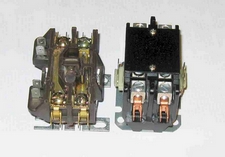
As you can see, the photo is named “Cheap vs OK”. That is, the cheap POS contactor from the AC on the left and its run-of-the-mill quality replacement on the right. The contrast is kinda stark, isn’t it? Notice that the old contactor only switched one leg. That left everything in the circuit hot, just waiting to bite the first guy who brushed up against the “off” circuit. That extra contact might have cost a couple of pennies. The new one obviously switches both legs like God intended!
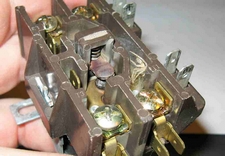
Here’s a close-up of the burned, folded, spindled and mutilated contact. A sorry mess, eh? Wait ’til you see it disassembled.
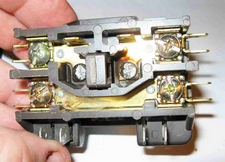
Here the contactor is with the movable contact removed. Note the friendly dead spider adjacent to the lower left screw terminal. That’s what went wrong! All the spidey power leaked out.
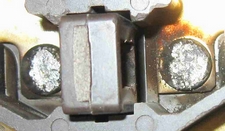
And an even closer shot showing the Massacre at the Contact Corral.
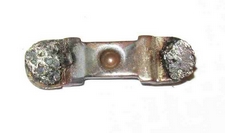
Here’s where the real damage occured. On the left, the silver contact button got so hot that the silver solder melted, letting it shift to one side. On the right, the silver button is simply gone, exposing the copper alloy underneath. This is the spot where the welding occured, preventing the compressor from turning off.
It started to rain before I could finish the last step – installing an anti-freeze-up thermostat. This thermostat, standard equipment on quality units, will stop the compressor when the evaporator temperature reaches about 35 degrees, on the verge of freezing. It will restart the compressor when the evaporator temperature rises to about 50 degrees. This gives any ice that may have formed plenty of time to melt. This action is independent of the indoor wall thermostat.
Posted by neonjohn on June 10th, 2008 under HVAC
Leave a Comment